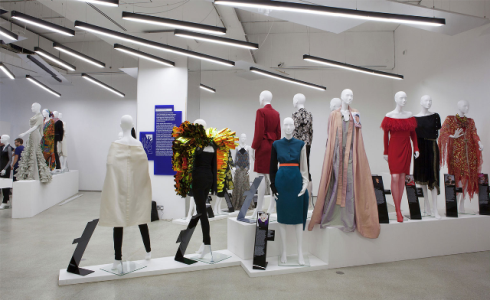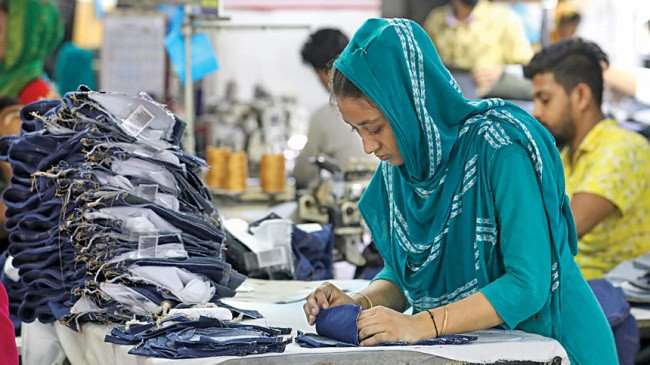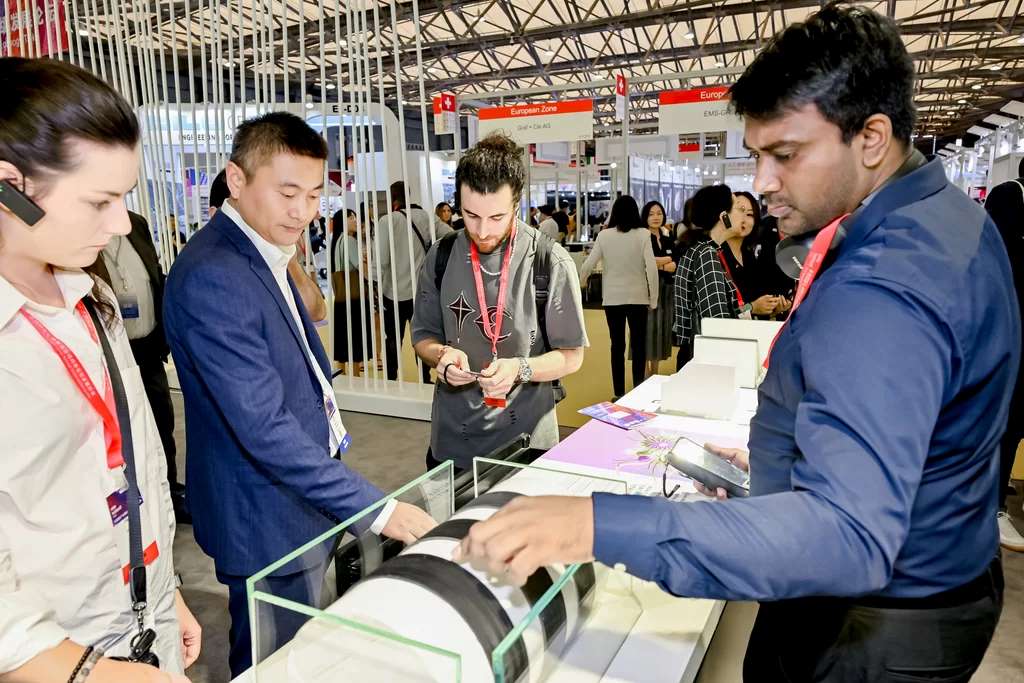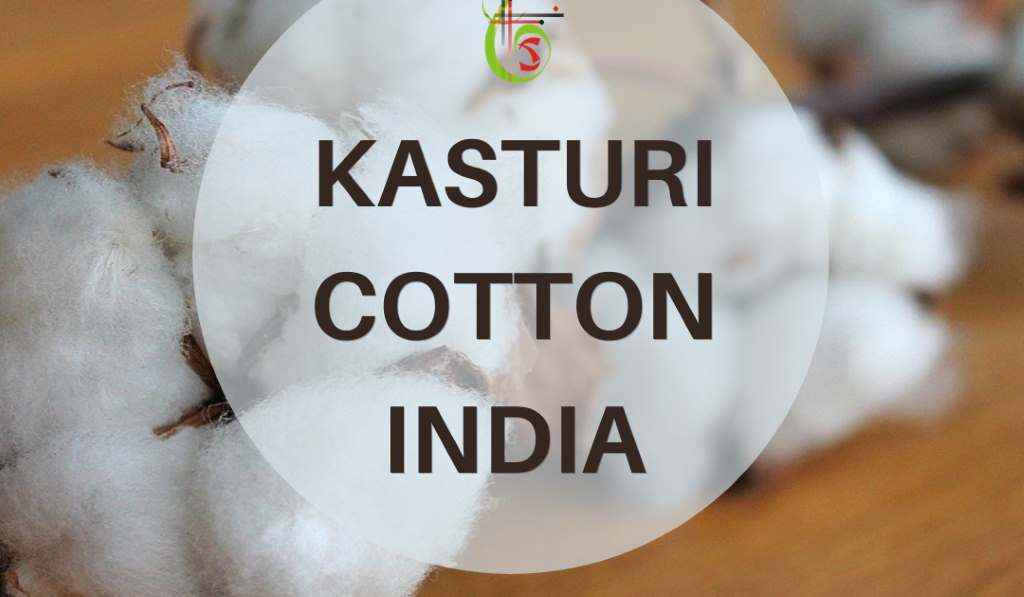FW
The textile and garment machinery exhibition held in Dhaka from February 4 to 7, 2015 saw exhibitors get orders worth more than $200 million. More than 30,000 local and international visitors visited the exposition. Around 880 exhibitors from about 32 countries and regions showcased a wide array of state-of-the-art textile and garment technologies, machinery and parts. Some 1,060 booths exhibited products of leading brands at the fair.
The expo introduced latest machines and technology to the country's textile and garment industry’s supply chain that includes spinning, weaving, knitting, dyeing, printing, finishing, testing, washing, embroidery, sewing, and other related equipment.
It was the ideal platform for local exporters to come in contact with relevant manufacturers, regional agents and wholesalers to source high quality machinery, equipment and materials under a single roof. Besides the host Bangladesh, other countries represented at the fair include: Austria, Belgium, Brazil, Canada, China, Czech Republic, Denmark, France, Germany, Hong Kong, India, Ireland, Italy, Japan, Korea, Malaysia, the Netherlands, Pakistan, Portugal, Romania, Singapore, Spain, Sri Lanka, Sweden, Switzerland, Taiwan, Thailand, Turkey, the UK, the USA and Vietnam.
BTMA and Chan Chao International and Yorkers Trade and Marketing Service of Taiwan jointly organised the expo which is regarded a mini version of the big regional exhibition, ITMA.
Tirupur’s knitwear hub South India has recorded a 19 per cent rise in exports in rupee terms to touch Rs 15,000 crores during the first nine months from April-December, of the current fiscal. With around 7,000 units out of which 85 per cent are small and medium enterprises (SMEs), the region’s exports in dollar terms were 18 per cent for the period under review.
As per A Sakthivel, President of the Tirupur Exporters Association (TEA), the export figure was arrived at after consolidating the bank-wise export data collected from banks. Now the players are optimistic about crossing the export figure of Rs 21,000 crores by March 2015, provided the industry is able to maintain the same growth trend in the fourth quarter. By 2016-17, exports are expected to reach Rs 36,000 crores, almost double the figure achieved in 2013-14.
Exporters from Tirupur have appealed to Finance Minister Arun Jaitley in a pre-Budget memorandum to address issues like announcement of three per cent interest subvention on rupee export credit, import of specialty fabrics without payment of duty under Export Performance Certificate Scheme and speedy initiation of FTAs with EU and Canada.
Power loom units in India will get a subsidy for upgradation. There will be no restrictions on the number of units eligible for receiving these benefits. These benefits will be given across the board to improve the quality of the product.
Of the over 20 lakh looms, only 1.25 lakh are fully mechanized. At present only a maximum of eight power looms can receive a subsidy of Rs 15,000 each under the scheme, which is also available only in select weaving clusters, like Erode and Salem. The idea is to help poor weavers and make weaving contribute significantly to the growth of the Indian textile industry.
Since 95 per cent of the textile machinery is being imported, there are lots of opportunities for entrepreneurs and the demand for looms can be met by domestic players. Though weaving is one of the important sectors for the Indian textile industry, it has not been given due attention unlike the spinning sector. The weaving sector consists of fragmented, small and often un-registered units that invest low amounts in technology and practices especially in power loom, processing, handloom and knits.
India has the world’s largest installed base for looms. The power loom sector produces more than 60 per cent of the cloth in India.
Britain's textile industry is forecasted to create 20,000 jobs in the next five years as a result of re-shoring of production and growth areas, including material for vehicles and aircraft. Apparel exports doubled in the decade to 2013, with 5,000 jobs created in that year alone. But a shortage of skilled staff and insufficient funding for investment could slow growth.
The UK is the 15th largest textile manufacturer in the world. Higher wages in Asia, and the trend for fast fashion, with customers favoring UK manufacturers, are expected to add to domestic sales. The advanced textile sector, which makes lightweight carbon fiber and other materials, has also provided a boost to clothing manufacturing. F1 cars are woven on the same jacquard loom as a wedding dress.
Online retailers buy all their clothes in the UK to ensure quick turnaround time. Other retailers sourcing more supply from the UK include Marks & Spencer. However, fast fashion can also result in small, uneconomic runs. Some retailers also treat suppliers poorly, with long payment terms or by demanding discounts. The micro businesses driving growth often lack money to invest and scale up. However, all accept that mass production of cheap clothes and household goods is unlikely to return.
ThreadSol Softwares has partnered with Mehala Machines to bring ThreadSol products in the Indian market. IntelloCut and intelloBuy, products from ThreadSol offer complete enterprise material management that helps manufacturers boost their top line by 50 percent by enabling up to 10 percent cost saving on fabric at the buying stage and reducing process loss to under 1 percent at the factory level.
Commenting on the association, Ashim Das, CEO of Mehala Machines said, “ThreadSol Softwares has already marked their presence in India by working with companies like Raymond and Blackberrys. We are pleased to partner with ThreadSol and would spread their revolutionary technology to a larger consumer base around the country.”
As CEO of ThreadSol, Manasij Ganguli says, “The 35 years of industry experience of Mehala and the innovation of ThreadSol will together form a team which can easily take on the challenges Indian apparel market faces today.”
Established in 2012, Threadsol Softwares is operational in India, Sri Lanka, Bangladesh, Turkey and Vietnam. ThreadSol is a name synonymous to consistent material saving and sustainable profit. Founded in 1974, Mehala Machines is recognized as one of the leading solution providers to the Indian apparel and leather goods industry. The product range under Mehala comprises of automatic CAD/CAM cutting machines, sewing machines, complete range of finishing equipment, unit production (hanger) systems, embroidery machines, inkjet digital printing machines, packaging machines, material handling systems and factory ventilation/cooling system among many others.
www.mehala.com
Taiwan Textile Federation and Gujnon have signed an agreement to expand economic and trading relations between Taiwan and Indian nonwoven industries. This concerns direct investments, joint ventures and marketing partnerships as well as all other forms of bilateral cooperation.
Gujnon is an association of manufacturers of nonwoven products in Gujarat. Gujarat has become a hub for nonwovens. There are some 40 nonwoven fabric units in the state and many more are in the pipe line. Gujnon’s objective is to promote the consumption of nonwovens, to widen the applications of nonwovens, and to spread the word that nonwoven is 100 per cent recyclable and reusable and, if burnt, does not lead to much air pollution. Products made with nonwovens are considered safe because they are non-toxic.
Taiwan Textile Federation and Gujnon will collaborate on a private-sector basis in protecting intellectual property rights (IPR), by cooperating to promote the exchange of information on policies and activities relating to IPRs in their regions and by striving to prevent infringement on IPRs in domestic and international trade practices.
Both will place at each other’s disposal information concerning investment conditions, relevant valid legal regulations, current trading and market access conditions, and will exchange regular statistics and newsletters.
Women who work in the coir sector will soon get machines that will make their life easier. This is a one-touch automatic pneumatic loom. It can be easily operated by a single person and will be beneficial to women, who account for more than 80 per cent of the workforce in the coir sector.
Most existing machines are operated through foot pedals with a capacity of 8 mt. a day. Moreover, they require at least two people to operate them. The new looms can weave up to 128 mt. of 2 mt. wide geo-textiles. It has a single touch operation and can be worked by one person. The machine can also be used for weaving other natural fibers such as cotton and jute.
The coir manufacturing industry produces mats, matting and other floor coverings. Coir is used as ship cables, for fenders and for rigging. Ropes and cordage, made out of coconut fiber, have been in use from ancient times.
Kerala is known for its coir industry. Coconut husks are beaten into fiber for making mats and other coir products. The coir industry is the largest cottage industry in Kerala. Women are mainly involved in the yarn spinning sector and men in the product-weaving sector.

Japan, is ready to roll out the red carpet for Indian textile manufacturers and designers to showcase their creativity to Japanese buyers and designers. The Japan India Industry Promotion Association (JIIPA) is organising the three-day ‘India Trends Fair 2015’ (ITF) in Tokyo from July 15 to 17 offering a comprehensive platform to Indian apparel manufacturers and designers.
Indian designers, apparel makers get a platform
Shigemaro Yasui, Chairman, JIIPA says, “JIIPA has been formed to foster business between India and Japan. Industrial and cultural exchanges between the two countries continue to gain momentum. The culture of fashion has been thriving strongly in response to the rapid growth in industrial and commercial relationships with a number of fashion events. The ‘India Trends Fair 2015’ in Tokyo will intensify the focus on fashion and create new perspectives. The scope of the fair extends beyond textiles and materials to encompass a fusion of new fashion and cultures.”

Yasui, further focuses on the need to strengthen business ties with India, “Japan imports 90 per cent apparels from China and only three per cent from India. We want India to be the best partner of Japan for which we need support and help of Indian people. We will start the initiative with textiles, which is an important consumer product. We want India to have a 65 per cent and China 30 per cent share. That will help India enter the Japanese mindset and fuel Japanese people’s interest in India which will also help tourism grow.”
Guiding participants on Japanese tastes
Besides organizing the fair, JIIPA also has plans to educate participants prior to the event. Throwing more light on this aspect, Yasui says, “As Indians know nothing about the latest trends in Japan, we’ve plans to brief them on how to design fashion products for Japan. We customize fashion and design for Japan. Indian manufacturers can bring these products to Japan through this trend fair to be held in July. This is also about home furnishings, handicrafts and accessories,” he explained.
The organizers also plan to hold ‘Trend Workshops’ in India prior to the Tokyo event. “In April we will participants an idea about next year’s trends in Japan. We will organize workshops and seminars for Indian manufacturers and designers in Delhi, Mumbai and other cities. We will coordinate with 20 to 30 companies and brief them on what they should make, and how to design our products. It will help them prepare for the exhibition,” Yasui informed.
ITF 2015 is supported by the Embassy of India in Tokyo, the Consulate General of India in Osaka-Kobe, the Japan-India Association, the Japan-India Business Cooperation Committee and Ministry of Economy, Trade and Industry.
Bowing to pressure from animal rights activists, Inditex, the world’s largest fashion retailer and parent company of Zara and Massimo Dutti, will stop selling clothing made from angora in its more than 6,400 stores around the world. Thousands of fluffy jumpers and angora coats and caps now sitting in its warehouses will be sent to Syrian refugees in Lebanon. The announcement comes after talks with People for the Ethical Treatment of Animal (Peta), which had conducted an investigation into the production of the luxury fibre.
Peta, after visiting angora farms in China, had released graphic footage in 2013 showing fur being ripped out of live rabbits to ensure the angora fibres were as long and thick as possible. The rabbits, whose front and back paws were tied, screamed and writhed in pain as their fur was torn out. Bald and bleeding, the rabbits were pushed back into cramped cages to regrow their fur until it could be plucked again.
The footage reflected the standard conditions for angora rabbits in China, which today is home to 90 per cent of the angora fur trade, said Peta. The investigation prompted several retailers, including Marks & Spencer, Topshop, Primark and H&M to stop selling garments made from angora.
Inditex, controlled by founder Amancio Ortega, one of the world’s richest people, initially stayed quiet. Now the company has said it will not be resuming sale of angora. After consultation with animal welfare organisations to explore more sustainable ways to produce angora and help develop better standards within the industry, it has decided to ban angora production. The Inditex statement was welcomed by Peta.
With 1,101 cents a kilogram, the highest point in two years, wool prices are seeing a decent rally in the past two weeks in Eastern Market Indicator. Fine wool has seen the largest price increase, with 17-micron wool making 1388 cents a kilogram, up 94 cents for the fortnight. Cardings made of 880 cents a kilogram, is believed to be a record high price. Stronger wool is also doing good with 30-micron wool making 765 cents a kilogram, the most the category has made in 60 years.
Bruce McLeish, wool manager with Elders northern, says the 60-cent rise in the past two weeks has been driven by the lower dollar and rising demand from the Chinese. China’s long awaited recovery appears to be gaining some strength, confidence does seem to be slowly returning to consumers there and there’s a flurry of domestic orders in the sweaters and other garments.
It has been a tough year to produce wool, with dry weather reducing lambing rates and wool yield and quality. The Australian Wool Production Forecasting Committee has forecast production in the 2014-’15 season at 334 million kg down by 2 per cent from the 2013-’14 season total of 341 million kg.












